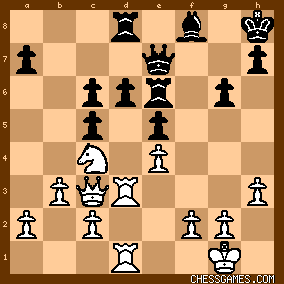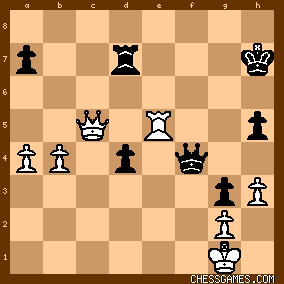| KEG: A very hard-fought and (for the most part) extremely well-played game that was decided by two blunders (32. f4 and 57. Re7+). Schlechter outplayed Janowski on the White side of the latter's Berlin Defense to the Ruy Lopez. In a nearly model display of how to exploit weak pawns (in this case Janowski's d-pawn and a-pawn), Schlechter built a strong position. Nothing brilliant, just relentless pressure. Janowski's tenacious defense barely kept him in the game. Janowski's problems began with his poor 13...Ng8 (13... a5 was much better), and his follow-up 14...Rab8 (14...Nf6) and 15...Qe5 (15...Ra8 was best), though typical of Janowski' love of counter-attack, only made things worse. Schelechter could perhaps have done better with 19. e5 (instead of 19. Nd5) or 20. Qa5 (instead of 20. Bc4), but his actual moves definitely kept the heat on Janowski's weak points. Janowski repeatedly found ways to stay in the game. But Janowski erred with 23...fxB (instead of 23...BxB and then with 31...Re6 (he had to try 31...Bg2 to avoid the devastating pin). Janowski's actual 31...Re6 left the position as follows: 
click for larger viewSchlechter played 32. f4. The Tournament Book faults Schlecter here for being too impatient to force matters. While 32. f4 was indeed a mistake, the error was not impatience to "force matters." Rather, Schlechter could have won here with 32. Nxe5! I bet Pillsbury or Lasker would have played this in a heartbeat. But somehow Schlechter, Janowski, and (most unforgivably) the Tournament Book missed this shot, which seems to win instantly (if. 32...Rxe5 33. f4). This was why Janowski should have played 31...Bg7. Even after this oversight, Schlechter continued to force play, but after his 37. Qc4+ (37. Qd2 was the only way to maintain any real advantage), chances were equal. Queen and Rook endings can be tricky (we all remember what happened to Taimanov in the fifth game of his match with Bobby Fischer!), and with Janowski involved play is never dull. Although the game was a theoretical draw, Janowski tried everything to complicate (for example, his 47...g5). Janowski could have sat back and taken a draw, but that would not be the Janowski we know and enjoy! With 54. Re5, Schlechter--uncharacteristically for him, also tried to mix things up (rather than just keep his Rook on the first rank to avoid checks). This brave venture allowed Janowski to play 54...Qf1+ and then 55...Qf4+ and finally 56...g3. According to the Tournament Book, Schlechter was now lost. But Schlechter was not lost. Here was the position after Janowski's 56...g3: 
click for larger viewIn fact, Schlechter would have been just fine after 57. Rf5. What lost the game for him was his 57. Re7+. In the heat of battle, Schlechter apparently overlooked the fact that Janowski could simply sacrifice his Rook with 57...Kh6! I bet Janowski found this winning reply in a flash. After 57. Re7+ Kh6 Schlechter--faced with mate in two beginning with Qf2+ and Janowski's advancing d-pawn--was indeed lost, and Janowski bludgeoned out a win in short order. Not a perfect game by any means, but a very instructive one for amateurs like me. What I got from this game were: (1) a demonstration by Schlechter on how to exploit weak pawns; (2) heroic defense of such weaknesses by Janowski; (3) a reminder that even a well-played game can be spoiled by a single mistake (here 32. f4); and (4) a caution--if one is truly needed--concerning the perils of Queen and Rook endings. | 




































